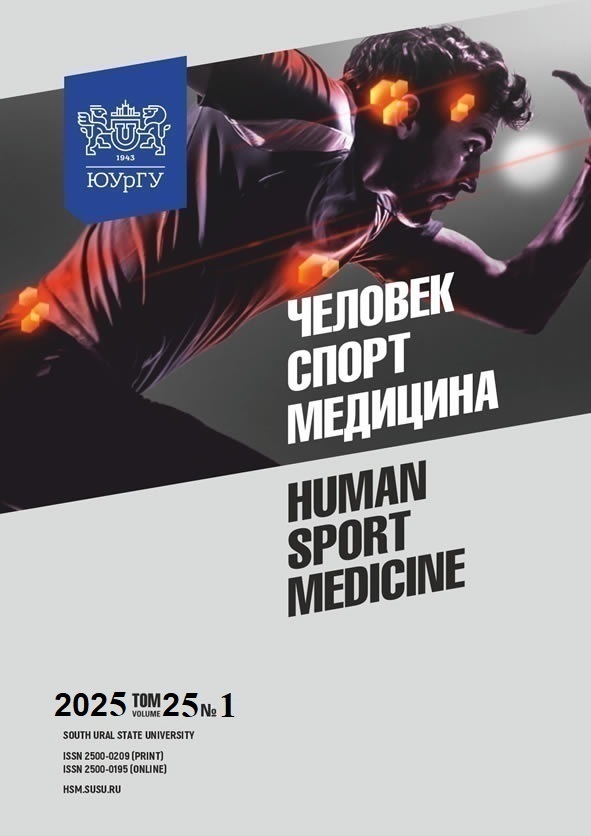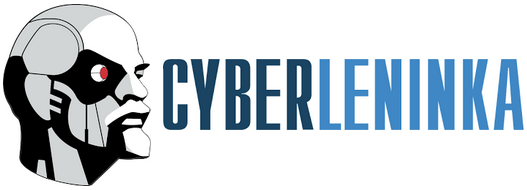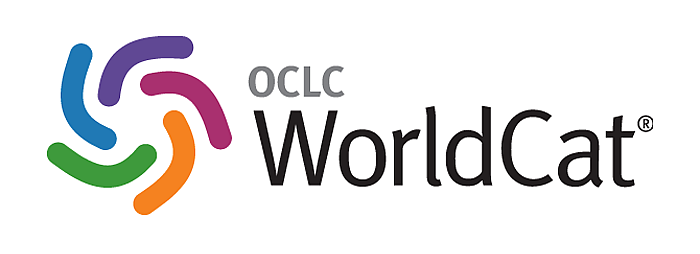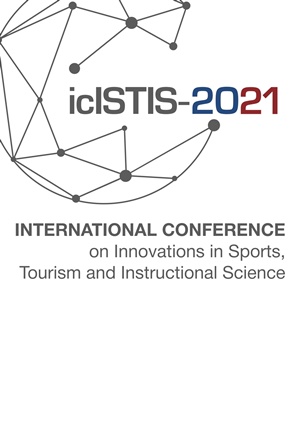ОСНОВНЫЕ ПАРАМЕТРЫ ЗАДЕРЖКИ ДЫХАНИЯ ВЫСОКОКВАЛИФИЦИРОВАННЫХ СИНХРОНИСТОК ОЛИМПИЙСКИХ КОМАНД ПО НОВЫМ ПРАВИЛАМ World Aquatics НА 2022–2025 ГОДЫ
Аннотация
Цель: определить стандарты задержки дыхания во время выполнения произвольной программы командами по синхронному плаванию, участвовавшими в Олимпийских играх 2020 (2021), чтобы помочь высококвалифицированным профессиональным пловцам избежать возможных долгосрочных последствий для здоровья в результате превышения этих ограничений. Материалы и методы. В качестве переменных в исследовании использовали продолжительность времени над и под поверхностью воды, тип и количество комбинаций, тайминг каждой комбинации, числовое значение каждой комбинации. Результаты показали, что наблюдается обратная зависимость между длительностью задержки дыхания и качеством выполнения произвольной программы в синхронном плавании. Лучшим соотношением задержки дыхания под водой и дыхания над водой признано соотношение 1:1 с продолжительностью нахождения под водой не более 25 секунд и общим количеством комбинаций не более 8. Заключение. Спортсменам следует выбрать подходящий режим дыхания, основанный на функциональной подготовленности и уникальных критериях эффективности,чтобы избежать синдрома REDs, поскольку он негативно влияет на все системы организма, приводя к ухудшению показателей здоровья.
Литература
2. Akgün G. Numerical Analysis of the Artistic Swimming Mixed Duet Free Routine Choreographies in World Championships, 2021.
3. Alentejano T., Marshall D., Bell G. A Time-motion Analysis of Elite Solo Synchronized Swimming. International Journal of Sports Physiology and Performance, 2008, vol. 3, pp. 31–40. DOI: 10.1123/ijspp.3.1.31
4. Alentejano T.C., Marshall D., Bell G.J. Breath Holding with Water Immersion in Synchronized Swimmers and Untrained Women. Research in Sports Medicine, 2010, vol. 18, pp. 97–114. DOI: 10.1080/15438620903323678
5. Auer R.N., Sutherland G.R. Hypoxia and Related Conditions. Greenfield’s Neuropathology, 2002, vol. 1, pp. 233–280.
6. Cialdella-Kam L., Guebels C., Maddalozzo G., Manore M. Dietary Intervention Restored Menses in Female Athletes with Exercise-Associated Menstrual Dysfunction with Limited Impact on Bone and Muscle Health. Nutrients, 2014, vol. 6, pp. 3018–3039. DOI: 10.3390/nu6083018
7. Dimitrova B. Comparative Analysis for the Hypoxic Sustainability of the Synchronized Swimmers from Bulgaria, Greece and Turkey. Research in Kinesiology, 2015, vol. 43. DOI: 10.5771/9783845260792-37
8. Elsherif O., Solomatin V.R. Distribution Analysis of Free and Technical Movements During Technical Routine for National Artistic Swimming Teams of Russia and Egypt in Olympics 2020 (2021). Modern University Sport Science: XVI Annual International Conference for Students and Young Researchers. Moscow, 2022, pp. 107–110.
9. [Elsherif O.A., Solomatin V.R. [Features of Breathing During the Technical Program Performance of the Russian and Egyptian Artistic Swimming Teams at the 32-year Olympic Games]. Teoriya i praktika fizicheskoy kul’tury: Trener: zhurn. v zhurn [Theory and Practice of Physical Education. Trainer. Journal in Journal], 2023, no. 1, pp. 100–102.]
10. Fédération Internationale de Natation. FINA Artistic Swimming Manual for Judges, Coaches & Referees 2017–2021. Available at: https://resources.fina.org/fina/document/2021/02/03/4d9cd6d0-5146-44ae-bf94-4ac757eaf34b/fina_as_manual_-_updated_august_2018_0.pdf (accessed 06.10.2024).
11. Fédération Internationale de Natation. FINA Artistic Swimming the New Scoring System September 2022 – Introductory Guide For Scoring Synchronization. Available at: https://learning.fina.org/wp-content/uploads/2022/03/25_01_2022_Synchronisation_Intro_Guide_v1_Jan_2022.pdf (accessed 06.10.2024).
12. Homma M., Okamoto Y., Takagi H. How do Elite Artistic Swimmers Generate Fluid Forces by Hand During Sculling Motions? Sports Biomechanics, 2019, pp. 1–15. DOI: 10.1080/14763141.2019.1671485
13. Li L., Xin X., Wei M. et al. Research on the Action Design of Team Artistic Swimming. International Journal of Sports Science and Physical Education, 2020, vol. 5, pp. 5–9. DOI: 10.11648/j.ijsspe.20200501.12
14. Loucks A.B. Energy Balance and Body Composition in Sports and Exercise. Journal of Sports Sciences, 2004, vol. 22, pp. 1–14. DOI: 10.1080/0264041031000140518
15. Loucks A.B., Kiens B., Wright H.H. Energy Availability in Athletes. Journal of Sports Sciences, 2011, vol. 29, pp. 7–15. DOI: 10.1080/02640414.2011.588958
16. Mountjoy M., Sundgot-Borgen J., Burke L. et al. The IOC Consensus Statement: Beyond the Female Athlete Triad – Relative Energy Deficiency in Sport (RED-S). British Journal of Sports Medicine, 2014, vol. 48, pp. 491–497. DOI: 10.1136/bjsports-2014-093502
17. Nakashima M., Hatakeyama G., Homma M., Ito K. Simulation Analysis of Lift in Synchronized Swimming. Journal of Aero Aqua Bio-mechanisms, 2013, vol. 3, pp. 51–56. DOI: 10.5226/jabmech.3.51
18. Naranjo J., Centeno R.A., Carranza M.D., Cayetano M. A Test for Evaluation of Exercise with Apneic Episodes in Synchronized Swimming. International Journal of Sports Medicine, 2006, vol. 27, pp. 1000–1004. DOI: 10.1055/s-2006-923846
19. Ntomali S., Adamakis M., Venetsanou F. et al. Which Factors are Influencing Artistic Swimming Performance? European Journal of Physical Education and Sport Science, 2021, vol. 6. DOI: 10.46827/ejpe.v6i12.3674
20. Peric M., Zenic N., Mandic G.F. et al. The Reliability, Validity and Applicability of Two Sportspecific Power Tests in Synchronized Swimming. Journal of Human Kinetics, 2012, vol. 32, p. 135. DOI: 10.2478/v10078-012-0030-8
21. Podrihalo O., Podrigalo L., Jagiełło W. et al. Substantiation of Methods for Predicting Success in Artistic Swimming. International Journal of Environmental Research and Public Health, 2021, vol. 18, p. 8739. DOI: 10.3390/ijerph18168739
22. Ponciano K., Miranda M.L.d.J., Homma M. et al. Physiological Responses During the Practice of Synchronized Swimming: a Systematic Review. Clinical Physiology and Functional Imaging, 2018, vol. 38, pp. 163–175. DOI: 10.1111/cpf.12412
23. Robertson S., Mountjoy M. A Review of Prevention, Diagnosis, and Treatment of Relative Energy Deficiency in Sport in Artistic (Synchronized) Swimming. International Journal of Sport Nutrition and Exercise Metabolism, 2018, vol. 28, pp. 375–384. DOI: 10.1123/ijsnem.2017-0329
24. Rodríguez-Zamora L., Iglesias X., Barrero A. et al. Physiological Responses in Relation to Performance During Competition in Elite Synchronized Swimmers. PLoS One, 2012, vol. 7, e49098. DOI: 10.1371/journal.pone.0049098
25. Schott L., Brusnikina O., Montero A. et al. Introductory Guide for the Application of Declared Difficulty, 2022.
26. Vassilios T., Chyssoula C., Sophia K., Rozi G. Differences in Physiological Responses of Synchronized Swimming Athletes and Female Swimmers. Evropejskij Žurnal Fizičeskoj Kulʹtury i Sporta, 2016, vol. 12, p. 58. DOI: 10.13187/ejpe.2016.12.58
27. Venkatraman J.T., Pendergast D.R. Effect of Dietary Intake on Immune Function in Athletes. Sports Medicine, 2002, vol. 32, pp. 323–337. DOI: 10.2165/00007256-200232050-00004
28. Viana E., Bentley D.J., Logan-Sprenger H.M. A Physiological Overview of the Demands, Characteristics, and Adaptations of Highly Trained Artistic Swimmers: a Literature Review. Sports Medicine-Open, 2019, vol. 5, pp. 1–9. DOI: 10.1186/s40798-019-0190-3
References
1. Akgün G. COMEN Cup Competition Points Analysis of Ariana Figure in Artistic Swimming. European Journal of Physical Education and Sport Science, 2021, vol. 7. DOI: 10.46827/ejpe.v7i2.38712. Akgün G. Numerical Analysis of the Artistic Swimming Mixed Duet Free Routine Choreographies in World Championships, 2021.
3. Alentejano T., Marshall D., Bell G. A Time-motion Analysis of Elite Solo Synchronized Swimming. International Journal of Sports Physiology and Performance, 2008, vol. 3, pp. 31–40. DOI: 10.1123/ijspp.3.1.31
4. Alentejano T.C., Marshall D., Bell G.J. Breath Holding with Water Immersion in Synchronized Swimmers and Untrained Women. Research in Sports Medicine, 2010, vol. 18, pp. 97–114. DOI: 10.1080/15438620903323678
5. Auer R.N., Sutherland G.R. Hypoxia and Related Conditions. Greenfield’s Neuropathology, 2002, vol. 1, pp. 233–280.
6. Cialdella-Kam L., Guebels C., Maddalozzo G., Manore M. Dietary Intervention Restored Menses in Female Athletes with Exercise-Associated Menstrual Dysfunction with Limited Impact on Bone and Muscle Health. Nutrients, 2014, vol. 6, pp. 3018–3039. DOI: 10.3390/nu6083018
7. Dimitrova B. Comparative Analysis for the Hypoxic Sustainability of the Synchronized Swimmers from Bulgaria, Greece and Turkey. Research in Kinesiology, 2015, vol. 43. DOI: 10.5771/9783845260792-37
8. Elsherif O., Solomatin V.R. Distribution Analysis of Free and Technical Movements During Technical Routine for National Artistic Swimming Teams of Russia and Egypt in Olympics 2020 (2021). Modern University Sport Science: XVI Annual International Conference for Students and Young Researchers. Moscow, 2022, pp. 107–110.
9. [Elsherif O.A., Solomatin V.R. [Features of Breathing During the Technical Program Performance of the Russian and Egyptian Artistic Swimming Teams at the 32-year Olympic Games]. Teoriya i praktika fizicheskoy kul’tury: Trener: zhurn. v zhurn [Theory and Practice of Physical Education. Trainer. Journal in Journal], 2023, no. 1, pp. 100–102.]
10. Fédération Internationale de Natation. FINA Artistic Swimming Manual for Judges, Coaches & Referees 2017–2021. Available at: https://resources.fina.org/fina/document/2021/02/03/4d9cd6d0-5146-44ae-bf94-4ac757eaf34b/fina_as_manual_-_updated_august_2018_0.pdf (accessed 06.10.2024).
11. Fédération Internationale de Natation. FINA Artistic Swimming the New Scoring System September 2022 – Introductory Guide For Scoring Synchronization. Available at: https://learning.fina.org/wp-content/uploads/2022/03/25_01_2022_Synchronisation_Intro_Guide_v1_Jan_2022.pdf (accessed 06.10.2024).
12. Homma M., Okamoto Y., Takagi H. How do Elite Artistic Swimmers Generate Fluid Forces by Hand During Sculling Motions? Sports Biomechanics, 2019, pp. 1–15. DOI: 10.1080/14763141.2019.1671485
13. Li L., Xin X., Wei M. et al. Research on the Action Design of Team Artistic Swimming. International Journal of Sports Science and Physical Education, 2020, vol. 5, pp. 5–9. DOI: 10.11648/j.ijsspe.20200501.12
14. Loucks A.B. Energy Balance and Body Composition in Sports and Exercise. Journal of Sports Sciences, 2004, vol. 22, pp. 1–14. DOI: 10.1080/0264041031000140518
15. Loucks A.B., Kiens B., Wright H.H. Energy Availability in Athletes. Journal of Sports Sciences, 2011, vol. 29, pp. 7–15. DOI: 10.1080/02640414.2011.588958
16. Mountjoy M., Sundgot-Borgen J., Burke L. et al. The IOC Consensus Statement: Beyond the Female Athlete Triad – Relative Energy Deficiency in Sport (RED-S). British Journal of Sports Medicine, 2014, vol. 48, pp. 491–497. DOI: 10.1136/bjsports-2014-093502
17. Nakashima M., Hatakeyama G., Homma M., Ito K. Simulation Analysis of Lift in Synchronized Swimming. Journal of Aero Aqua Bio-mechanisms, 2013, vol. 3, pp. 51–56. DOI: 10.5226/jabmech.3.51
18. Naranjo J., Centeno R.A., Carranza M.D., Cayetano M. A Test for Evaluation of Exercise with Apneic Episodes in Synchronized Swimming. International Journal of Sports Medicine, 2006, vol. 27, pp. 1000–1004. DOI: 10.1055/s-2006-923846
19. Ntomali S., Adamakis M., Venetsanou F. et al. Which Factors are Influencing Artistic Swimming Performance? European Journal of Physical Education and Sport Science, 2021, vol. 6. DOI: 10.46827/ejpe.v6i12.3674
20. Peric M., Zenic N., Mandic G.F. et al. The Reliability, Validity and Applicability of Two Sportspecific Power Tests in Synchronized Swimming. Journal of Human Kinetics, 2012, vol. 32, p. 135. DOI: 10.2478/v10078-012-0030-8
21. Podrihalo O., Podrigalo L., Jagiełło W. et al. Substantiation of Methods for Predicting Success in Artistic Swimming. International Journal of Environmental Research and Public Health, 2021, vol. 18, p. 8739. DOI: 10.3390/ijerph18168739
22. Ponciano K., Miranda M.L.d.J., Homma M. et al. Physiological Responses During the Practice of Synchronized Swimming: a Systematic Review. Clinical Physiology and Functional Imaging, 2018, vol. 38, pp. 163–175. DOI: 10.1111/cpf.12412
23. Robertson S., Mountjoy M. A Review of Prevention, Diagnosis, and Treatment of Relative Energy Deficiency in Sport in Artistic (Synchronized) Swimming. International Journal of Sport Nutrition and Exercise Metabolism, 2018, vol. 28, pp. 375–384. DOI: 10.1123/ijsnem.2017-0329
24. Rodríguez-Zamora L., Iglesias X., Barrero A. et al. Physiological Responses in Relation to Performance During Competition in Elite Synchronized Swimmers. PLoS One, 2012, vol. 7, e49098. DOI: 10.1371/journal.pone.0049098
25. Schott L., Brusnikina O., Montero A. et al. Introductory Guide for the Application of Declared Difficulty, 2022.
26. Vassilios T., Chyssoula C., Sophia K., Rozi G. Differences in Physiological Responses of Synchronized Swimming Athletes and Female Swimmers. Evropejskij Žurnal Fizičeskoj Kulʹtury i Sporta, 2016, vol. 12, p. 58. DOI: 10.13187/ejpe.2016.12.58
27. Venkatraman J.T., Pendergast D.R. Effect of Dietary Intake on Immune Function in Athletes. Sports Medicine, 2002, vol. 32, pp. 323–337. DOI: 10.2165/00007256-200232050-00004
28. Viana E., Bentley D.J., Logan-Sprenger H.M. A Physiological Overview of the Demands, Characteristics, and Adaptations of Highly Trained Artistic Swimmers: a Literature Review. Sports Medicine-Open, 2019, vol. 5, pp. 1–9. DOI: 10.1186/s40798-019-0190-3
Copyright (c) 2025 Человек. Спорт. Медицина

Это произведение доступно по лицензии Creative Commons «Attribution-NonCommercial-NoDerivatives» («Атрибуция — Некоммерческое использование — Без производных произведений») 4.0 Всемирная.
